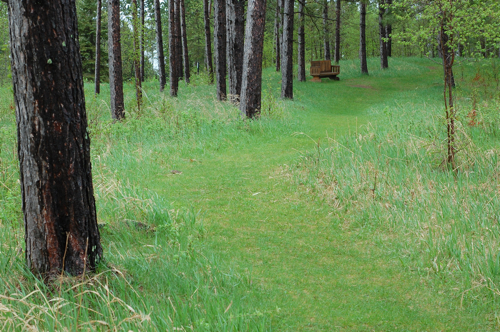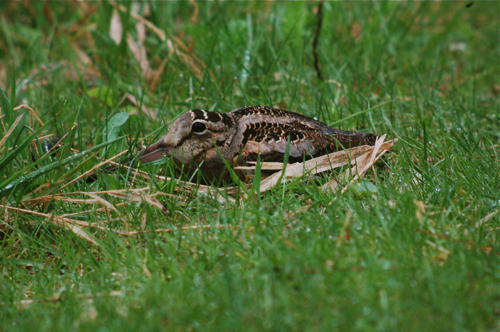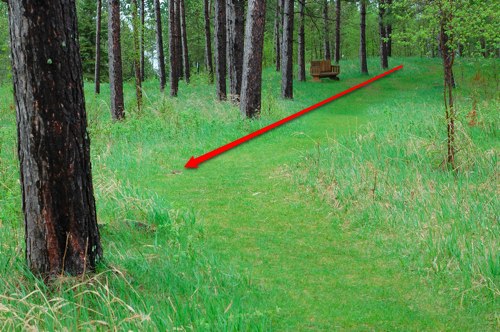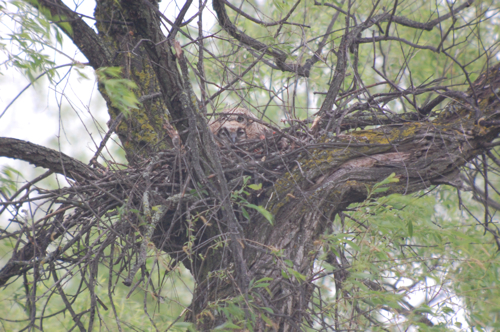 When I drove up for the Detroit Lakes Bird Festival, it was very hot and warm. Friday while birding at Agassiz, it was cooler, but by afternoon it was very hot. That night some incredible storms moved in. Jeff Bouton and Ben Lizdas and I headed to Hamden Slough for a scan of birds and could see some powerful lightening coming our way in the distance. That night the lightening flashed like crazy. One interesting note was that Jeff discovered a couple of tundra swans mixed in with trumpeter swans. Above is a photo of a trumpeter on the left and a tundra on the white. Note how the tundra swan has a slightly thinner neck and the dainty look of the bill. You can't see it in the photo, but through out scopes you could see yellow on the bill.
When I drove up for the Detroit Lakes Bird Festival, it was very hot and warm. Friday while birding at Agassiz, it was cooler, but by afternoon it was very hot. That night some incredible storms moved in. Jeff Bouton and Ben Lizdas and I headed to Hamden Slough for a scan of birds and could see some powerful lightening coming our way in the distance. That night the lightening flashed like crazy. One interesting note was that Jeff discovered a couple of tundra swans mixed in with trumpeter swans. Above is a photo of a trumpeter on the left and a tundra on the white. Note how the tundra swan has a slightly thinner neck and the dainty look of the bill. You can't see it in the photo, but through out scopes you could see yellow on the bill.
 The next morning it was cold and windy at Rothsay Prairie. Not the best weather for listening for those quieter prairie sparrow species like Le Conte's sparrows but we did see some other species. Above is a swamp sparrow that was fairly accommodating.
The next morning it was cold and windy at Rothsay Prairie. Not the best weather for listening for those quieter prairie sparrow species like Le Conte's sparrows but we did see some other species. Above is a swamp sparrow that was fairly accommodating.
 Clay-colored sparrows were also lurking about in the grasses. I love that little buzzy call they give.
Clay-colored sparrows were also lurking about in the grasses. I love that little buzzy call they give.
 And of course, bobolinks were all over. We saw large flocks of males flying up from the roads--they are so pretty and hypnotic with the bold black and white coloration.
And of course, bobolinks were all over. We saw large flocks of males flying up from the roads--they are so pretty and hypnotic with the bold black and white coloration.
 Of course, the fun of the prairie are the shorebirds. Here is a marbled godwit that we found working the road. The bird appears to have an injured foot but was able to fly and find food. I love how birds are still able to survive and function even what appears to be a tragic injury.
Of course, the fun of the prairie are the shorebirds. Here is a marbled godwit that we found working the road. The bird appears to have an injured foot but was able to fly and find food. I love how birds are still able to survive and function even what appears to be a tragic injury.
 We saw some more phalaropes. Above is a male Wilson's phalarope--these guys are interesting because the females are more colorful than the males and after she lays eggs, leaves the male to incubate and raise the chicks.
We saw some more phalaropes. Above is a male Wilson's phalarope--these guys are interesting because the females are more colorful than the males and after she lays eggs, leaves the male to incubate and raise the chicks.
We had so much fun at this particular pond. The bus pulled over and Doug Buri and Bob O'Connor stepped outside to scan it for interesting shorebirds. They thought they saw a Hudsonian godwit. I remained on the bus with the rest of the passengers. Being on the bus, we were higher up and could look down on the shorebirds. Suddenly people started asking me, "Hey, Sharon, what's that yellow shorebird?" I scanned the water and found it right away--it stuck out like a sore thumb. The color was kind of yellow, kind of orange, but the bus windows and cloudy day was probably distorting the color. I stuck my head out the window and shouted, "Hey, Doug, Bob, what's that yellowish bird--buff breasted sandpiper?" Well, they were on the ground and could only see the head being lower than we were. They both looked at the head and said, "We're not sure." I got back on the bus and announced, "It's gotta be good, the experts don't know what it is!" Everyone on the bus got a great look at it. I started running the little hamster in my brain--"What shorebird would be yellowish? Yellow...yellow...well, actually it's salmon color...I remember reading a book about researchers in the 1970s and 1980s coloring shorebirds to study migratory patters...what birds were those...shorebirds...they were red knots...WAIT! RED KNOT!!"
I stuck my head out the window and both Doug and Bob looked at me and we shouted at the same time, "Red Knot!" We had all worked it out in our heads simultaneously. The bird was going into breeding plumage to get that red color and that's why it looked salmon-ish (something we're not used to in Minnesota). As we were getting people off the bus the knot took off with some short-billed dowitchers, but at the point everyone had been watching for awhile. It was so windy, we tried to follow it, but the wind could have blown it into Canada. We made an immediate call to our inside man at the MOU to let him know what we saw and where. When our field trip returned, we gave out directions and maps but the knot was not seen for the rest of the festival. It was interesting, the shorebirds at that pond were changing all day, so with the wind I'm sure many birds were just passing through.
 Rothsay is known for it's prairie chickens--we saw some, but they were hunkered and way out in the fields. Above is a shot of the giant prairie chicken in the town or Rothsay. Doug didn't want to stop and look at a big plastic bird but there was some mutiny on the bus and he lost. He didn't hesitate to tell us how ridiculous it was that we made a point to see it.
Rothsay is known for it's prairie chickens--we saw some, but they were hunkered and way out in the fields. Above is a shot of the giant prairie chicken in the town or Rothsay. Doug didn't want to stop and look at a big plastic bird but there was some mutiny on the bus and he lost. He didn't hesitate to tell us how ridiculous it was that we made a point to see it.
I love heart Buri.
 While on one of the birding trips for the Detroit Lakes Festival of Birds, we visited Tamarac National Wildlife Refuge. There had been a woodcock nesting right off a trail near the Nature Center. As we walked towards it, the female appeared to have moved to right on the trail. The refuge staff suspected that her eggs had hatched. They are precocial when hatched meaning they can run around. She was probably moving them from the nest, heard us coming and froze tucking the young beneath her. Can you make her out in the above photo?
While on one of the birding trips for the Detroit Lakes Festival of Birds, we visited Tamarac National Wildlife Refuge. There had been a woodcock nesting right off a trail near the Nature Center. As we walked towards it, the female appeared to have moved to right on the trail. The refuge staff suspected that her eggs had hatched. They are precocial when hatched meaning they can run around. She was probably moving them from the nest, heard us coming and froze tucking the young beneath her. Can you make her out in the above photo?


 I was archiving some photos and found this photo from this year's Detroit Lakes Festival of Birds of a great horned owl nest with 2 chicks. I figured the least I could do is post this photo after yesterday's link to a flycatcher eating what appears to be Cthulu.
I was archiving some photos and found this photo from this year's Detroit Lakes Festival of Birds of a great horned owl nest with 2 chicks. I figured the least I could do is post this photo after yesterday's link to a flycatcher eating what appears to be Cthulu.